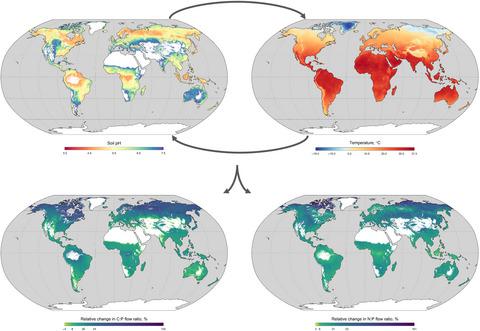当前位置:
X-MOL 学术
›
Glob. Change Biol.
›
论文详情
Our official English website, www.x-mol.net, welcomes your
feedback! (Note: you will need to create a separate account there.)
Temperature and pH mediate stoichiometric constraints of organically derived soil nutrients
Global Change Biology ( IF 10.8 ) Pub Date : 2021-11-12 , DOI: 10.1111/gcb.15985 Ligia F T Souza 1 , Sharon A Billings 1
Global Change Biology ( IF 10.8 ) Pub Date : 2021-11-12 , DOI: 10.1111/gcb.15985 Ligia F T Souza 1 , Sharon A Billings 1
Affiliation

|
It remains unclear how warming will affect resource flows during soil organic matter (SOM) decomposition, in part due to uncertainty in how exoenzymes produced by microbes and roots will function. Rising temperatures can enhance the activity of most exoenzymes, but soil pH can impose limitations on their catalytic efficiency. The effects of temperature and pH on enzyme activity are often examined in environmental samples, but purified enzyme kinetics reveal fundamental attributes of enzymes’ intrinsic temperature responses and how relative release of decay-liberated resources (their flow ratios) can change with environmental conditions. In this paper, we illuminate the principle that fundamental, biochemical limitations on SOM release of C, N, and P during decay, and differential exoenzymes’ responses to the environment, can exert biosphere-scale significance on the stoichiometry of bioavailable soil resources. To that end, we combined previously published intrinsic temperature sensitivities of two hydrolytic enzymes that release C and N during decay with a novel data set characterizing the kinetics of a P-releasing enzyme (acid phosphatase) across an ecologically relevant pH gradient. We use these data to estimate potential change in the flow ratios derived from these three enzymes’ activities (C:N, C:P, and N:P) at the global scale by the end of the century, based on temperature projections and soil pH distribution. Our results highlight how the temperature sensitivity of these hydrolytic enzymes and the influence of pH on that sensitivity can govern the relative availability of bioavailable resources derived from these enzymes. The work illuminates the utility of weaving well-defined kinetic constraints of microbes’ exoenzymes into models that incorporate changing SOM inputs and composition, nutrient availability, and microbial functioning into their efforts to project terrestrial ecosystem functioning in a changing climate.
中文翻译:

温度和 pH 值调节有机衍生土壤养分的化学计量约束
目前尚不清楚变暖将如何影响土壤有机质 (SOM) 分解过程中的资源流动,部分原因是微生物和根产生的外酶如何发挥作用的不确定性。温度升高可以增强大多数外酶的活性,但土壤 pH 值会限制它们的催化效率。温度和 pH 值对酶活性的影响通常在环境样品中进行检查,但纯化的酶动力学揭示了酶内在温度响应的基本属性,以及衰变释放资源的相对释放(它们的流量比)如何随环境条件而变化。在本文中,我们阐明了衰变过程中 C、N 和 P 的 SOM 释放的基本生化限制以及不同的外酶对环境的反应的原理,可以对生物可利用土壤资源的化学计量产生生物圈尺度的意义。为此,我们将先前发表的两种水解酶在衰变过程中释放 C 和 N 的固有温度敏感性与表征 P 释放酶(酸性磷酸酶)在生态相关 pH 梯度上的动力学的新数据集相结合。我们使用这些数据根据温度预测和土壤估计到本世纪末全球范围内这三种酶的活性(C:N、C:P 和 N:P)所产生的流量比的潜在变化pH 分布。我们的研究结果强调了这些水解酶的温度敏感性和 pH 值对这种敏感性的影响如何控制源自这些酶的生物可利用资源的相对可用性。
更新日期:2022-01-16
中文翻译:

温度和 pH 值调节有机衍生土壤养分的化学计量约束
目前尚不清楚变暖将如何影响土壤有机质 (SOM) 分解过程中的资源流动,部分原因是微生物和根产生的外酶如何发挥作用的不确定性。温度升高可以增强大多数外酶的活性,但土壤 pH 值会限制它们的催化效率。温度和 pH 值对酶活性的影响通常在环境样品中进行检查,但纯化的酶动力学揭示了酶内在温度响应的基本属性,以及衰变释放资源的相对释放(它们的流量比)如何随环境条件而变化。在本文中,我们阐明了衰变过程中 C、N 和 P 的 SOM 释放的基本生化限制以及不同的外酶对环境的反应的原理,可以对生物可利用土壤资源的化学计量产生生物圈尺度的意义。为此,我们将先前发表的两种水解酶在衰变过程中释放 C 和 N 的固有温度敏感性与表征 P 释放酶(酸性磷酸酶)在生态相关 pH 梯度上的动力学的新数据集相结合。我们使用这些数据根据温度预测和土壤估计到本世纪末全球范围内这三种酶的活性(C:N、C:P 和 N:P)所产生的流量比的潜在变化pH 分布。我们的研究结果强调了这些水解酶的温度敏感性和 pH 值对这种敏感性的影响如何控制源自这些酶的生物可利用资源的相对可用性。











































 京公网安备 11010802027423号
京公网安备 11010802027423号